Sikalidis C. (ed.) Advances in Ceramics - Synthesis and Characterization, Processing and Specific Applications
Подождите немного. Документ загружается.

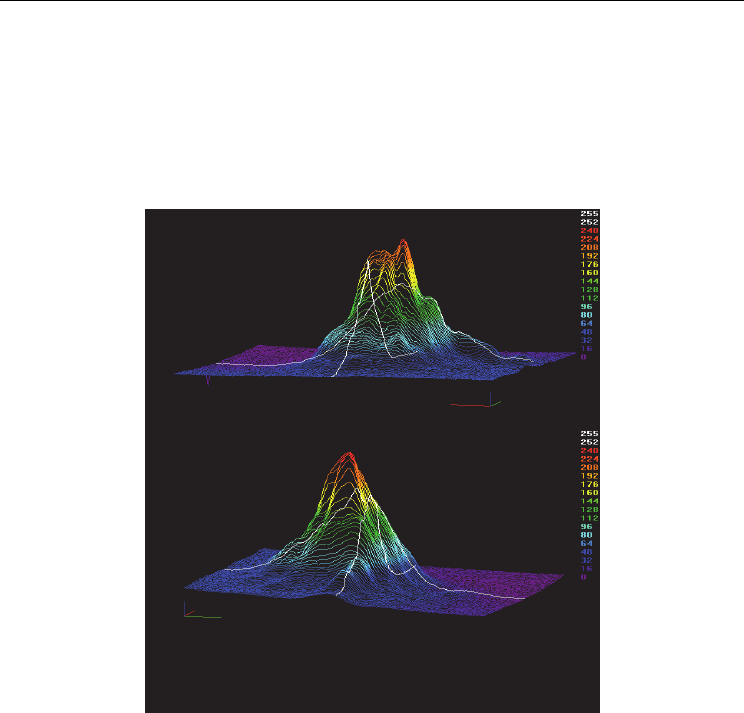
Laser Applications of Transparent Polycrystalline Ceramic
459
corresponding slope-efficiency was 29.8%. Electro-optical Q-switched ceramics laser with
higher modulating repetition rates generated higher average output power but broader
pulse width and lower pulse energy and peak power. No saturation phenomenon was
observed and higher output energy could be in expectation. Because the thermal build up of
higher repetition rate pulse laser is more serious than that of lower repetition rate pulse
laser, so the thermal depolarization losses of 1k Hz pulse laser were higher than those of 100
Hz pulse laser, which resulted lower efficiency than the latter.
Fig. 14. Beam profile of Nd:YAG ceramics laser under different modulating rates from CCD.
Figure. 14. showed the three-dimensional beam profiles of the pulse Nd:YAG ceramics laser
with different modulating rates and under the max pumping power of 420 W from CCD.
They were approximate Gaussian beam intensity distribution, but a little distortion
indicated some thermal stress-induced birefringence was existed.
In conclusion, a high energy electro-optical Q-switched Nd:YAG ceramics laser has been
demonstrated by employing a quite uniformly compact side-pumping system. The laser
parameters between ceramics and single crystal Nd:YAG lasers have been compared and
the pulse characteristics of ceramics laser with different repetition rates have been discussed
in detail. With 100 Hz modulating rate, output energy of 50 mJ has been attained with pulse
width of 10 ns and average output power of 5 W. And its corresponding peak power was 5
MW. While with 1 kHz modulating rate, output energy of 28.3 mJ has been achieved with
pulse width of 12 ns and an average output power of 28.3 W. Table.1. Summarized the
measured laser parameters with the effective pumping energy of 420 mJ at 1064 nm. It
approved in experimental that Nd:YAG ceramics has comparable good performance with
(a) 1 kHz
(b) 100 Hz
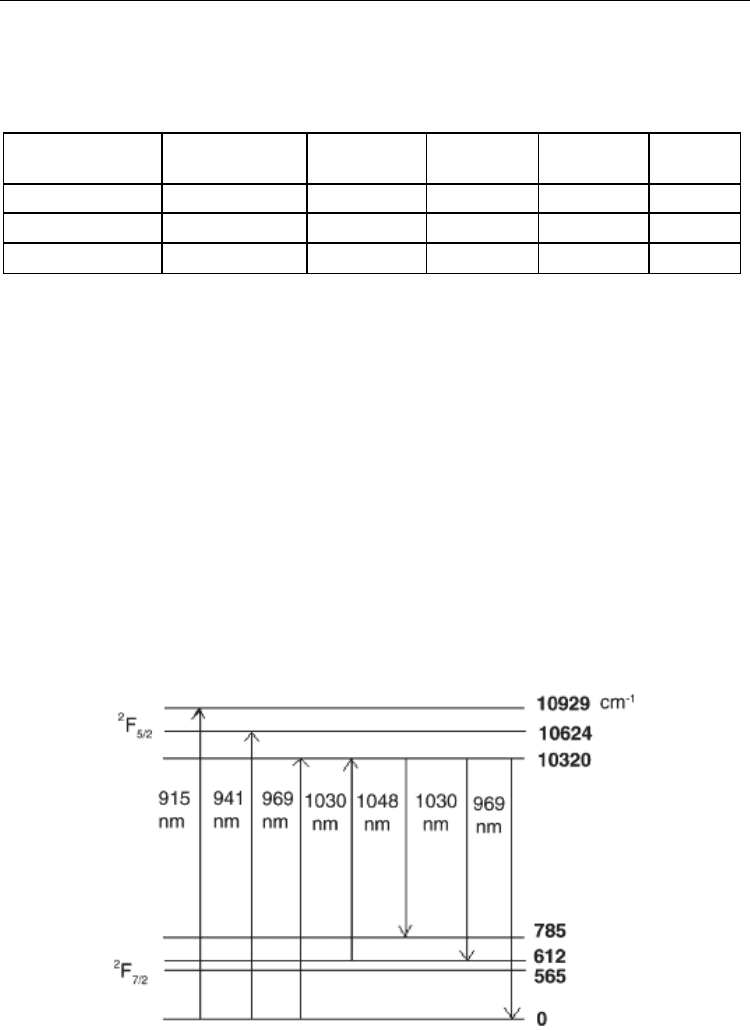
Advances in Ceramics - Synthesis and Characterization, Processing and Specific Applications
460
Nd:YAG single crystal in mJ-level energy laser output. By optimizing the design of the laser
cavity, adopting higher pumping power and choosing proper repetition rate, the Nd:YAG
ceramics Electro-optical Q-switched laser will obtain better performance with higher pulse
energy and narrower line width as well as better beam quality.
1at.% Ceramics
Average output
Power
Pulse energy Pulse width Peak power
Slope
efficiency
Quasi-CW 236 W 236 mJ 160μs 1.6 kW 62 %
Pulse (1 kHz)
28.3 W 28.3 mJ 12 ns 2.36 MW 15.2 %
Pulse (100 Hz)
5 W 50 mJ 10 ns 5 MW 29.8 %
Table 1. Experimental laser parameters of Nd:YAG lasers at 1064 nm with effective pumping
energy of 390W.
5. Q-switched pulsed ceramics laser
5.1 CW and Q-Switched performance of a Yb:YAG/YAG composite thin disk ceramics
laser
Since the emergence of semiconductor laser diodes (LD) that emit at 900 ~ 1100 nm, high
power LD array are used as stabilized pumping source. The Yb doped laser material with
the pumping wavelength requirement at this wavelength range attracts a lot of attention.
[17] Figure. 15. shows the energy level of Yb
3+
ion in the crystal Yb:YAG.[18] Yb
3+
ion has
very simple energy diagram with
2
F
7/2
as lower level and
2
F
5/2
as excited state manifolds
separated by about 10,000 cm
-1
. The laser wavelength of ~ 1030 nm with transition of
2
F
5/2
-
2
F
7/2
has a terminal level of 612 cm
-1
above the ground states. While the thermal energy at
room temperature is 200 cm
-1
, the terminal state is thermally populated making the Yb:YAG
a quasi-three level system. At room temperature, the thermal population of the lower laser
level is about 5.5%.
Fig. 15. Energy level of Yb [2]
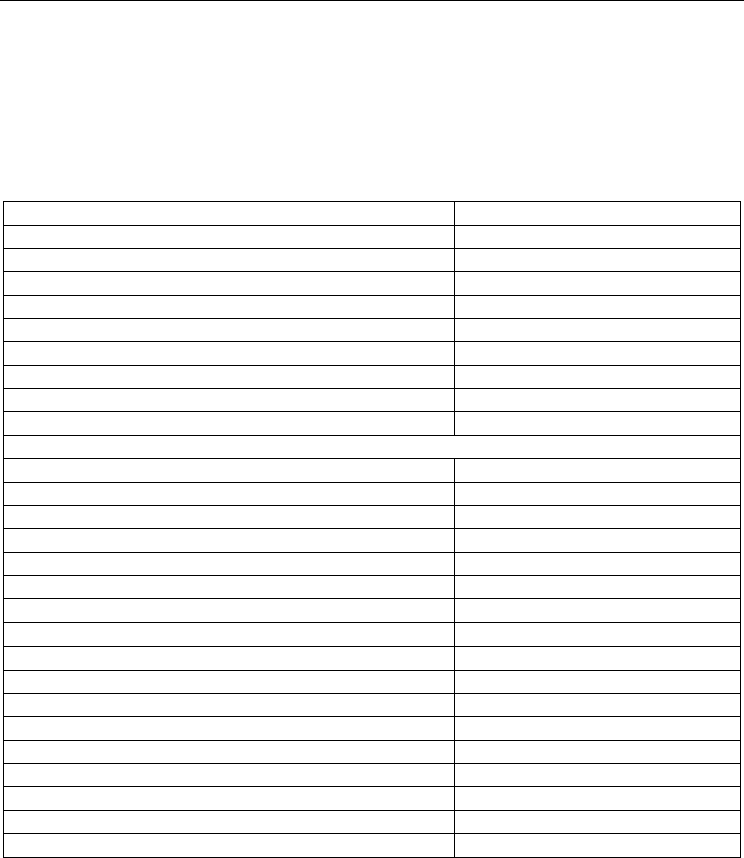
Laser Applications of Transparent Polycrystalline Ceramic
461
Table 2 summarized physical, chemical and laser properties of Yb:YAG single crystal. [19-
21] Comparing to the Nd:YAG laser material, Yb doped laser material have the merits of (1)
wide pumping range, (2) high quantum efficiency of over 90%, (3) longer upper-state
lifetime of ~1ms, (4) no excited state absorption, (5) no up-conversion, and (6) minimal
concentration quenching. With the fast development of the Nd:YAG transparent ceramics,
the Yb doped laser ceramics also shows its potential as one of the ideal candidates for high-
power laser application.
Crystal Structure Cubic
Lattice Parameters (nm) 1.201
Melting Point (K) 2243
Moh Hardness 8.5
Density (g/cm
3
) 4.56±0.04
Specific Heat (0-20) (J/g.cm
3
) 0.59
Modulus of Elasticity (GPa) 310
Young's Modulus (Kg/mm
2
) 3.17*104
Poisson Ratio (est.) 0.3
Tensile Strength (GPa) 0.13 ~ 0.26
Thermal Expansion Coefficient(/K) (0~250℃)
[100]Direction 8.2*10
-6
[110]Direction 7.7*10
-6
[111]Direction 7.8*10
-6
Thermal Conductivity (W/m/K) 14 @ 20℃, 10.5 @ 100℃
Thermal Optical Coefficient (dn/dT, /K ) 7.3*10
-6
Thermal Shock Resistance(W/m) 790
Laser Transition
2
F
5/2
→
2
F
7/2
Laser Wavelength
1030nm,1048nm
Photon Energy (J) 1.93*10
-19
@ 1030nm
Emission Linewidth (nm) 9
Emission Cross Section (cm
2
) 2.0*10
-20
Fluorescence Lifetime (ms) 1.2
Diode Pump Band (nm) 940 or 970
Pump Absorption Band Width (nm) 8
Index of Refraction 1.82
Thermal Optical Coefficient (/K) 9*10
-6
Loss Coefficient (cm
-1
) 0.003
Table 2. Physical and chemical property of Yb:YAG
Comparing to rod shape medium in which heat is along the radius of the rod, so there is
strong thermal gradient induced lensing and birefringence, in the thin disk shaped gain
medium heat is extracted through the large faces with thermal gradients which is
established across the smallest dimension and aligned with the beam propagation direction.
[22] But thermo-mechanical distortion is still the bottleneck of high-power thin disk laser.
Researchers brought up the idea of using composite media. During the pumping process,
the undoped part of the medium helps to defuse the heat generated by the doped part,
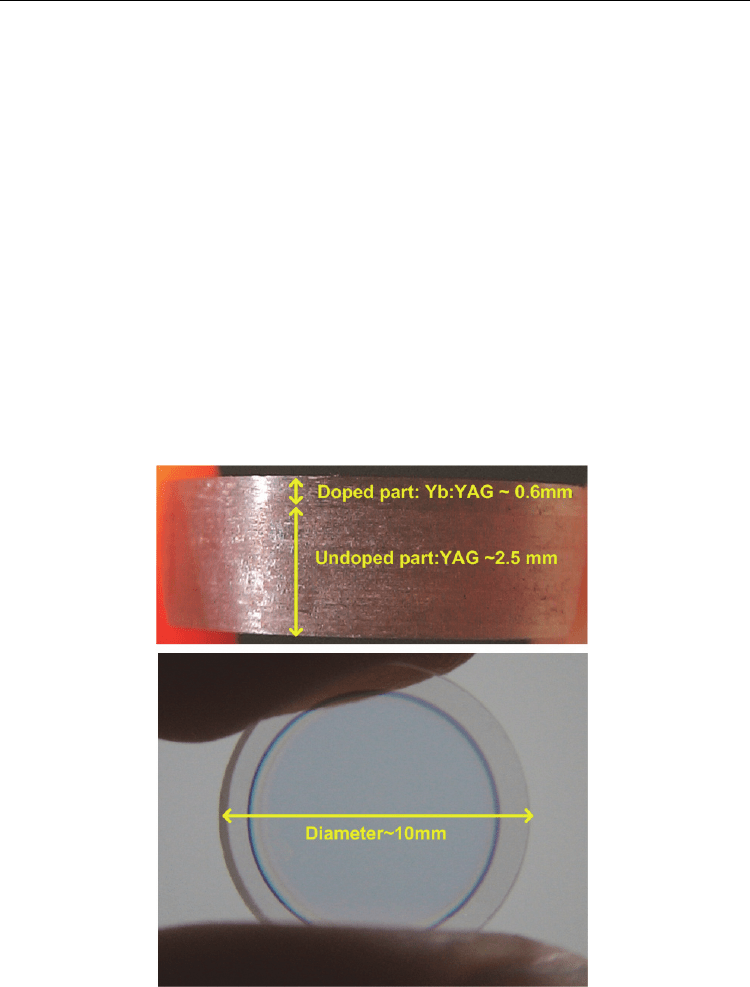
Advances in Ceramics - Synthesis and Characterization, Processing and Specific Applications
462
because the thermal conductivity of undoped part is usually higher than that of doped part.
In the case of Yb:YAG/YAG medium, the undoped YAG acts as a passive heat sink and
rebuilds the temperature field, especially along the thickness direction, and it seems that
there is an imaginary cooling effect on the front face of the gain medium. [23] So by using a
composite gain medium, which consists of both Yb:YAG and undoped YAG, the bending of
the medium can be eliminated to some degree. Additionally, the composite medium
eliminates the radiation trapping to a larger degree because the undoped YAG mitigates the
effects of total internal reflection at the undoped-YAG-air interface. [24]
Figure. 16. shows the pictures of the composite Yb:YAG/YAG thin disk ceramics made by
BAIKOWSKI, Japan. The thin disk is ~10 mm in diameter with very thin absorbing part of
the disk (~0.6 mm) bonded together with a thicker undoped piece of YAG ceramics (~2.5
mm). The doping concentration is 9.8 at.% in the doped part. The composite ceramics disk is
AR coated for the wavelength of ~930-970 nm and laser radiation 1030 nm at the front side
and HR coated for both wavelengths at the back side. Figure.17. shows the double-pass
absorptivity of the disk ceramics. There are mainly three absorption peaks in the range of
900 nm ~ 1100 nm: 937nm,968nm and 1027nm, with absorption efficiency of ~ 75%, 58%
and 38.7%, absorption bandwidth of ~ 37nm, 10nm and 14nm respectively.
Fig. 16. Pictures of Yb:YAG/YAG composite transparent ceramics disk
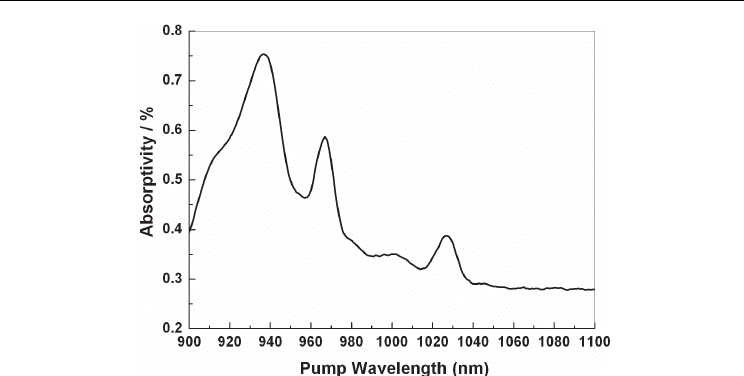
Laser Applications of Transparent Polycrystalline Ceramic
463
Fig. 17. Double-pass absorptivity of the composite ceramics
In order to lengthen the effective absorbing length in the thin-disk medium and make a
good overlap between pump and resonator mode, a face-pumped CAMIL structure is
chosen. With this structure, diode pump radiation is injected into the back face of the disk
and then reflected by the face several times. The schematic diagram of the experimental
setup is shown in 18. The laser medium is a composite Yb:YAG/YAG thin disk ceramics as
described above. It is fixed with a layer of indium onto a heat sink, which is cooled with
water from the back side. A collimated LD array with central wavelength at 970 nm working
at 15
o
C is used as pump source. By a focal length of ~ 9.4 cm lens, the pumping light is
focused on the back side of the ceramics and the unabsorbed pumped radiation is reflected
for another turn of absorption, i.e., the effective absorbing length is twice the length of the
doped ceramics. A dichroic beam splitter (45
o
) which is coated with AR film at 970nm and
HR film at 1030nm is inserted between the focusing lens and the composite ceramics for
redirecting the laser to the output couplers.
In the CW mode, output couplers with the same radius of curvature of 100 mm, and
transmissions of 1%, 2%, 5% and 10% are used respectively. The whole cavity length is ~80
mm. In the Q-switched mode, output coupler with transmission of 10% is used. The output
laser power is measured by a power meter (OPHIR, NOVA II) and the spectrum is recorded
by a spectroscopy (YOKOGAWA, AQ6370), while the pulse width is recorded by an
oscillograph (Lecroy, WR62XR).
In the CW mode, the laser output power increases as the pump power increases with
different output couplers, as shown in figure. 19. Up to 1.05W CW power is achieved with
optical to optical efficiency of 5.25% with 2% output coupler. Central laser wavelength is at
1031 nm, as shown in Fig.20. We also get Q-switched output of the laser using an acousto-
optic (A-O) Q-switch. We insert the A-O Q-switch device (Gooch & Housego, M080-2G) into
the cavity with 10% transmission output coupler. Stable operation is achieved with the
repetition rate of 1 kHz, 5 kHz, 10 kHz, 20 kHz and 30 kHz, along with the average output
power of 0.44 W, 0.446 W, 0.452 W, 0.461 W and 0.47 W respectively. Figure. 21. shows the
width of the pulse enlarges with the increasing repetition rate. Figure 22 shows the pulse
waveform at 1 kHz: a minimal pulse width of 166 ns and corresponding peak power of 2.6
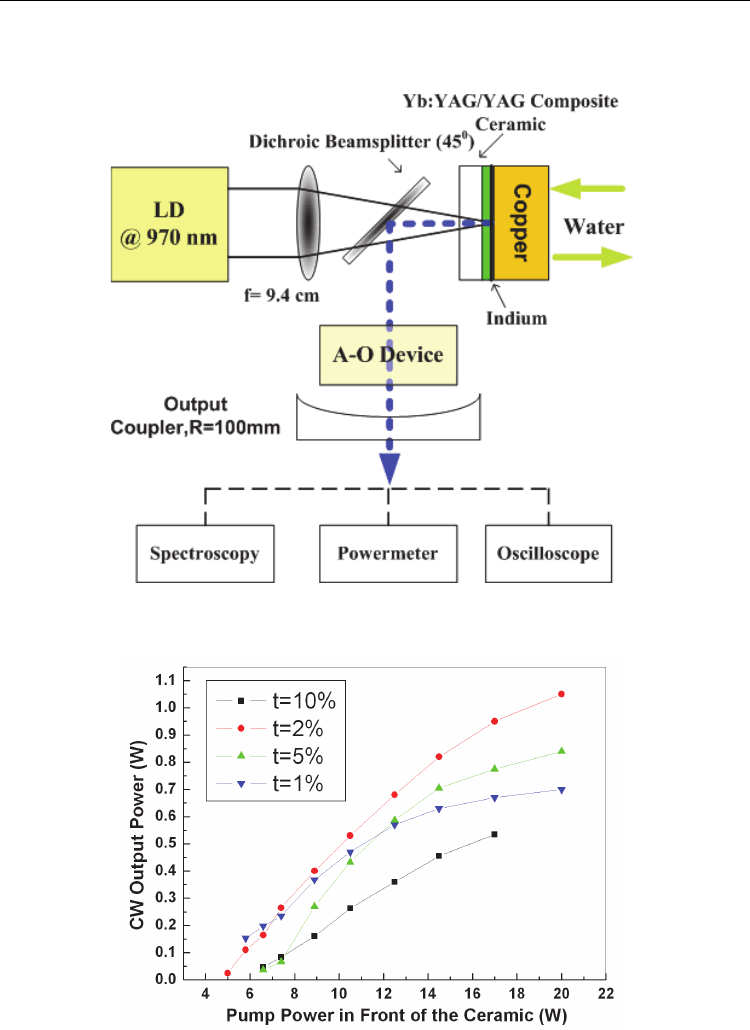
Advances in Ceramics - Synthesis and Characterization, Processing and Specific Applications
464
kW. Figure. 22. inset also shows the pulse serial, which appears to be a bit unstable but
acceptable.
Fig. 18. Schematic diagram of the experimental setup
Fig. 19. CW laser output power vs. Pump power with different output transmission
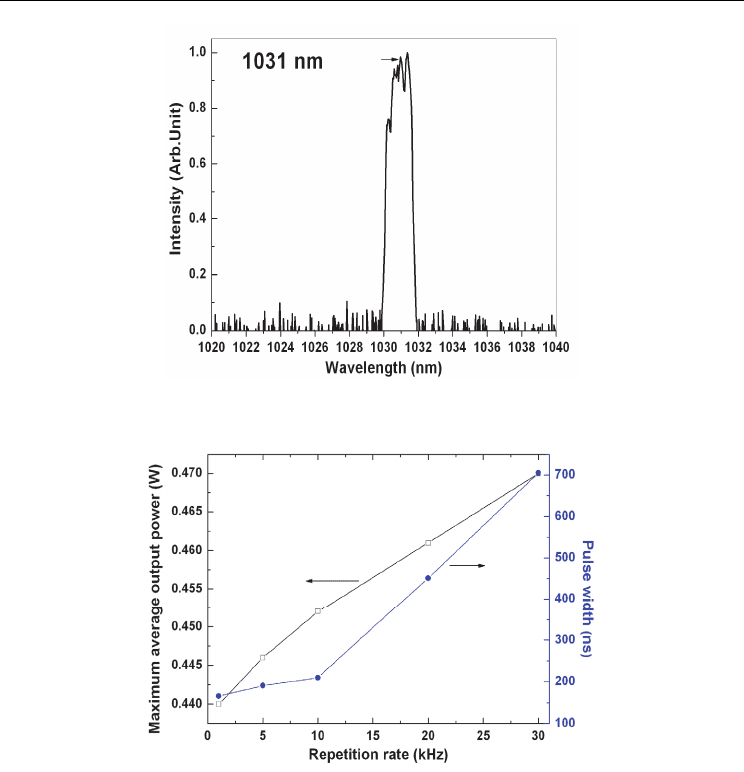
Laser Applications of Transparent Polycrystalline Ceramic
465
Fig. 20. Laser output spectrum
Fig. 21. Average output power and Pulse width vs. Repetition rate
Both for CW and AO Q-switched mode, the optical to optical efficiency is low according to
the data figure 19 and figure 21. But when we considered the actual absorbed pump power,
the case would be different. There is only 53.5% of the pump power can be absorbed at the
pump wavelength 970 nm, as shown in Fig.17. Moreover, further measurement reveals that
the pumping wavelength drifted dramatically along with the increasing pump power.
Figure 23 shows the measured relationship of pump wavelength and pump power while
maintaining the temperature of the cooling water at 15
o
C. The pumping central wavelength
drifts from 970 nm to 979 nm with the decreased pumping absorptivity from 53.5% to 38%,
respectively. Figure. 19. also suggests that in higher pump power region, the laser power
tended to be “saturated”, which is possibly caused by the decreasing absorption efficiency
of the medium. Form this experiment, we found that it’s difficult to control the pump
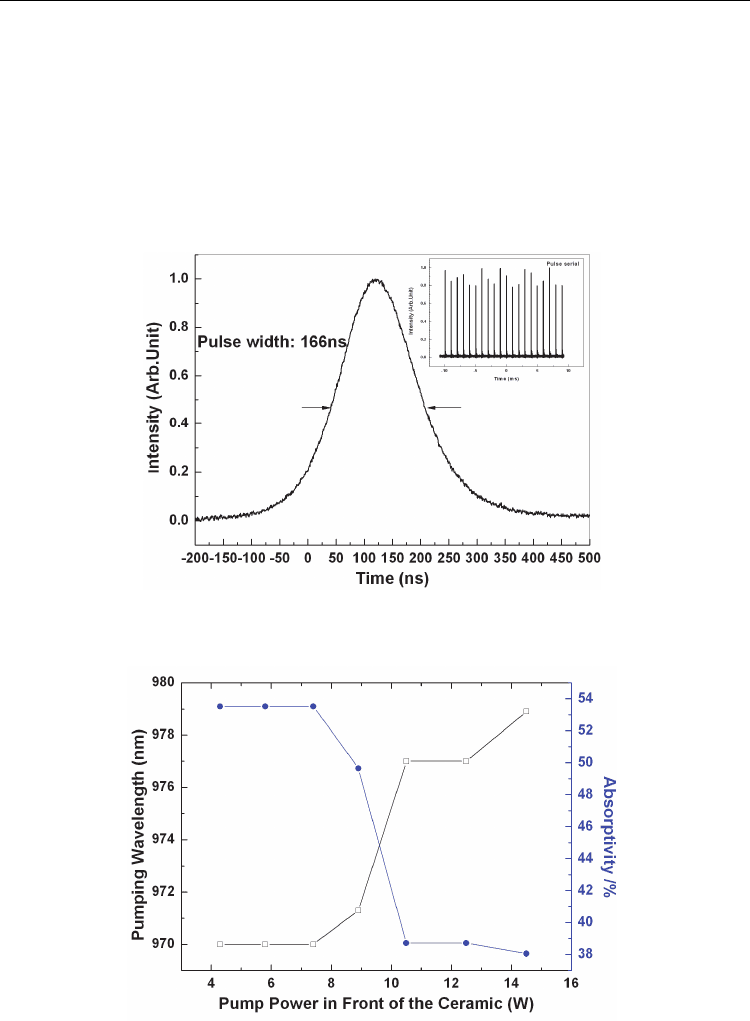
Advances in Ceramics - Synthesis and Characterization, Processing and Specific Applications
466
wavelength only by cooling in this pump source. Figure 17 indicates that the lengthened
absorbing length inside the laser medium brought about 28% background absorption of the
pump power, which might be caused by the quality of the media. It would raise the laser
threshold. Figure 17 also shows that there is another absorption peak at around 1031 nm
where is exactly the output laser wavelength located, indicating the reabsorption effect at
1031 nm. Thus, the increasing pumping power would lead to a stronger reabsorption results
in a quick saturation at this wavelength. Moreover, the unabsorbed pump energy would
contribute to the difficulty of the population inversion, thermal lensing, which would
further reduce the efficiency and the laser output power.
Fig. 22. Pulse profile of minimum pulse width at 1 kHz. Inset shows the pulse serial.
Fig. 23. Pump wavelength drifted with pump power and their corresponding absorptivity
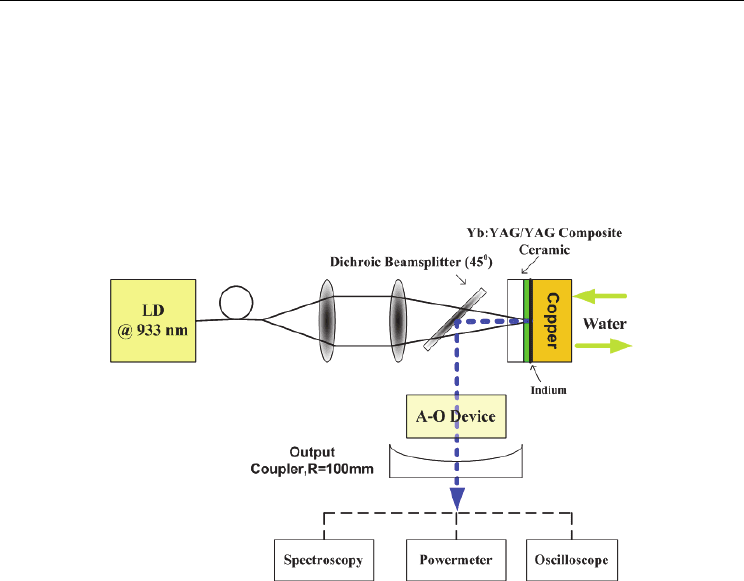
Laser Applications of Transparent Polycrystalline Ceramic
467
5.2 Experimental setup for 933 nm pumping experiment
We also study the CW and AO Q-switched laser performance of this Yb:YAG/YAG
composite ceramics disk under the pumping wavelength of ~933 nm in order to further
explore the high-power potential of this material by increasing the media absorption of
pumping power.
Figure 24 shows the schematic diagram of the experimental setup using 933 nm pump
source. The experimental setup is similar to that of ~970 nm pump source. The pump source
is a fiber coupled LD array with central wavelength at 933 nm working at 20℃.
Fig. 24. Schematic diagram of the experimental setup
In the CW mode, output couplers with the same radius of curvature of 100 mm, and
transmissions of 1%, 2%, 5% and 10% are used respectively. The whole cavity length is ~80
mm. In the Q-switched mode, output coupler with transmission of 10% is used. The output
laser power is measured by a power meter (OPHIR, NOVA II) and the spectrum is recorded
by a spectroscopy (YOKOGAWA, AQ6370), while the pulse width is recorded by an
oscillograph (Lecroy, WR62XR).
In the CW mode, the laser output power increases as the pump power increase with
different output couplers, as shown in Figure. 25. When the transmission of the output
coupler is 2%, up to 2.575 W CW power is achieved with optical-optical efficiency of 17.6%
and slope efficiency of 31.2%. Central laser wavelength is at 1030.2 nm, as shown in Fig.26.
Because of the limited output power of the pump source, the maximum output laser power
is not high enough. But from figure 25, the output laser shows no saturated intention, which
means higher laser output can be achieved in the future.
We also get Q-switched output of the laser using an acousto-optic (A-O) Q-switch. We insert
the A-O Q-switch device (Gooch & Housego, M080-2G) into the cavity with 10%
transmission output coupler. Stable operation is achieved with the repetition rate of 1.1 kHz,
5 kHz, 10 kHz, 20 kHz, 30 kHz, and 40 kHz along with the average output power of 1.29 W,
2.119 W, 2.221 W, 2.237 W, 2.246 W and 2.249W respectively. Figure 27 shows the width of
the pulse enlarges and the maximum peak power of the pulse decreases with the increasing
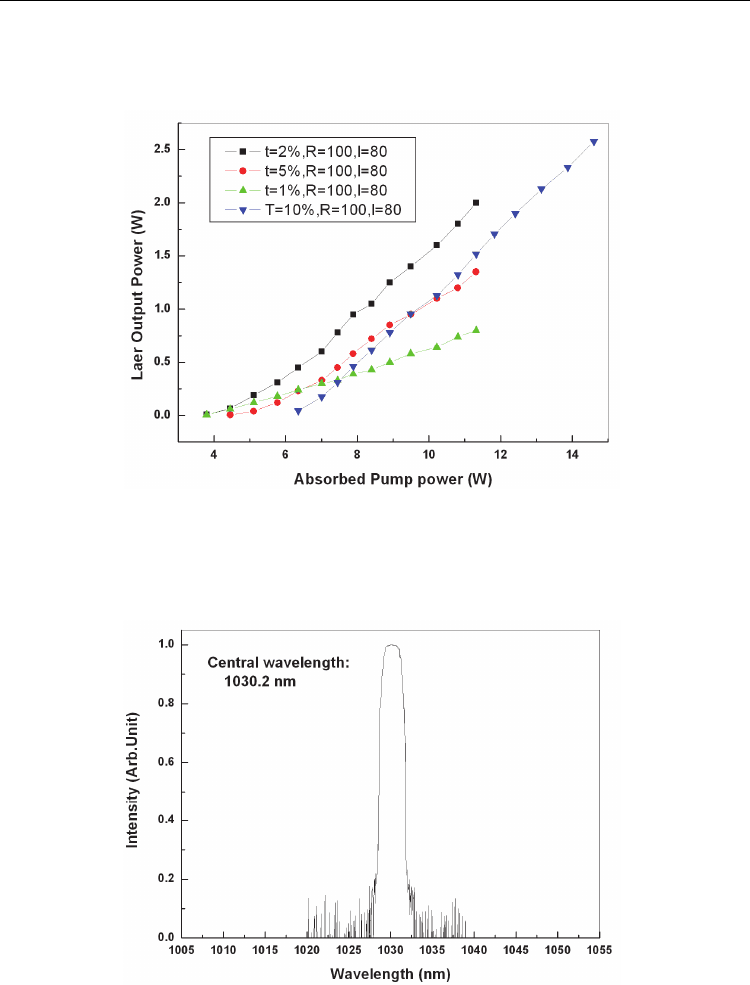
Advances in Ceramics - Synthesis and Characterization, Processing and Specific Applications
468
repetition rate. Fig. . shows the pulse waveform at 1.1 kHz: a minimal pulse width of 29 ns
and corresponding peak power of 40.4 kW, single pulse energy of 1.17mJ.
Fig. 25. CW laser output power vs. Pump power with different output transmission
Fig. 26. Laser spectrum
